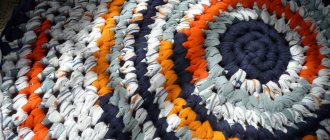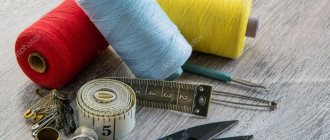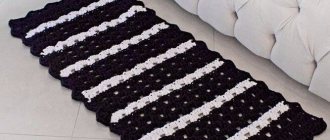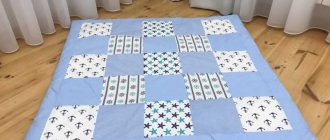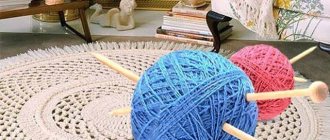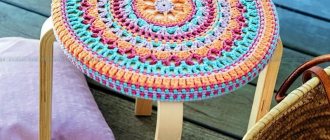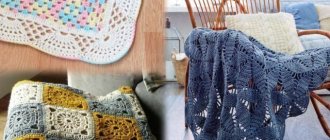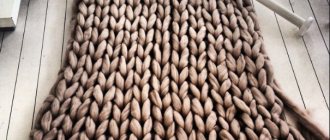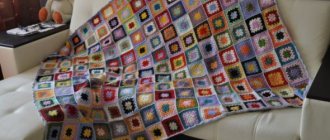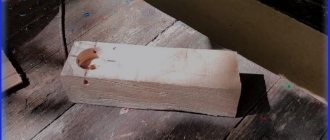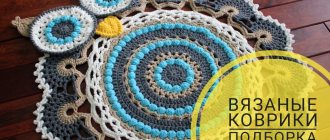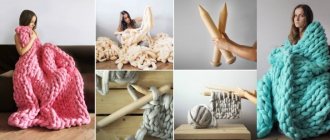We all periodically want to update the interior of our home and add coziness. When there are not enough resources for grandiose changes, cute little things come to the rescue - decorative pillows, blankets, rugs. Lately, knitted home decor has become the most popular. An original hand-made carpet can unite the interior of a room into a single whole. Even a novice needlewoman will be able to knit an original rug on her own, which will decorate the room and add color and texture to it. And besides this - additional pride of the hostess.
Which yarn to choose for knitting a rug
The beauty and practicality of the product will depend on how correctly the material for knitting is selected.
Before work, you need to decide on the size and texture of the future rug. Small canvases look good from:
- thick wool blend yarn. Experienced craftswomen note that yarn from Troitsk has performed well when knitting carpets. The products are incredibly soft and pleasant to the touch, and do not pill during use;
- pure acrylic. The main advantages of acrylic are that the products have dust-repellent properties and are easy to clean. In addition, acrylic knitted products do not deform after washing, do not fade, and have hypoallergenic properties;
- cotton threads. Ideal for creating openwork rugs. Such decorative elements are practical due to their light weight and are easy to care for.
Large knitted carpets look impressive if knitted from:
- knitting yarn. This is a relatively new material, which consists of long narrow ribbons of knitted fabric without knots or joints. Products made from such yarn look especially stylish in a modern interior;
- rope yarn (threads resembling lace or rope for macramé). May have different thicknesses and textures depending on the manufacturer. Well suited for dense products that require additional rigidity.
Many needlewomen choose textured yarn for knitting rugs: “grass”, threads with pom-poms, loops, bouclé and other interesting elements. In the Alize yarn line you can find threads with an unusual structure to suit every taste, bringing a wide variety of ideas to life.
What materials are carpets and rugs crocheted from, and how are they made?
Craft stores sell a wide variety of knitting materials. They differ in properties and price. Before choosing a material, you need to study the properties of each so that the finished product lasts a long time and does not lose its appearance.
- Yarn. Knitting from thick threads is the most popular direction in this type of creativity. Most often, this yarn is fluffy, which gives the rug softness. Sheep or camel wool is used, so the rug is not only beautiful, but also warm.
- Jute. Threads consist of coarse fiber twisted into a bundle. This material is durable and does not collapse when exposed to moisture. A jute rug is wear-resistant and suitable for a hallway or living room where there is no high humidity.
- Cords. The rope consists of polyester, which is woven in a special way, which gives the material special strength. Such carpets are hypoallergenic and do not attract dust. Polyester cord is more expensive than conventional materials and requires a special weaving technique. Therefore, this material is not recommended for beginners.
- Packages. This is one of the cheapest materials. Plastic bags do not absorb moisture and do not slip. This rug is suitable for the bathroom and in rooms with high humidity. The material is easy to wash and dries quickly.
- Strips of fabric. Any fabric is suitable for making rugs. The material used is old unnecessary clothing, towels, and diapers. The fabric is cut into strips of approximately the same width. A rug made using this technique looks unusual.
Criteria for choosing flooring material in different rooms
When choosing yarn, you need to consider the purpose of the room. High humidity and frequent washing can lead to destruction of the material, loss of shape and the appearance of mold.
- Wear-resistant rugs made from plastic bags are suitable for a bathroom or toilet. Due to their structure, the mats are not filled with moisture, which will prevent mold and deformation. They are easily washed in soapy water and dry quickly.
- It is especially important to use safe materials in a children's room. Polyester cord will do. The material does not attract dust and prevents the appearance of dust mites. The embossed surface will be especially interesting for children.
- In the living room or bedroom, the rug does not wear out much and does not get dirty. Therefore, natural wool or jute is suitable. An interesting solution would be strips of unnecessary fabric. When washed, jute absorbs moisture and takes a long time to dry, which provokes the appearance of mold. Carpets made of yarn and fabric may lose their shape if they come into frequent contact with water. It is recommended to use a vacuum cleaner to clean these rugs.
Round mat for beginners
Materials and tools : knitting yarn 3-4 skeins, hook No. 9-12
Description of work:
- Knit 11 double crochets into the amigurumi ring (SS2H).
- Cast on three air loops (VP) of lifting, knit two CC2H into each column of the existing row.
- Three VPs, knit 2 CC2H into the first column of the previous row, and one CC2H into the second. Repeat this sequence of actions until the end of the row.
- Knit five VP lifts. In the second column of the connected row, knit one CC2H, cast on two VPs, knit one CC2H, skipping one column of the previous row. It should look like in the picture.
- Three VP lifts, tie the previous row with single crochet stitches (SS1H).
- Three VPs, in one column - two CC1H, in the other - one CC1H.
- The seventh row is knitted like the fourth (see point 4).
- The eighth row is knitted by analogy with the fifth (point 5).
- Three VP lifts, one CC1H in each loop of the previous row.
- The ninth row is knitted like the fourth and seventh.
- This row is worked like the fifth and eighth.
- Continue knitting until the diameter of the rug reaches the desired size.
- Last row: make one VP, put one single crochet in it, knit 6 CC1H into the third column of the previous row, then cast on two VP, skip two columns of the lower tier, knit six CC1H into the third. Continue to the end of the row.
Product options and step-by-step knitting process
In stores you can find a variety of carpets for the home. They are made of different materials and have a variety of designs and patterns. There are knitted, cotton, woolen, multi-layer and other rugs on sale that can fit perfectly into any interior style. But handmade products have always been and will be valuable decorative elements that have a unique look.
You can make your own polyester or cotton mat in different shapes. To make it you need to use a hook, knitting needles or other special elements. But in this matter you cannot do without diagrams, templates, photos and knowledge of the basic rules.
Round or oval carpet
To make a round rug, it is recommended to select patterns and patterns for knitting. The process itself looks like this:
- Knitting a braided rug must include stitches.
- To knit the second row, you need to make two stitches from each loop.
- In the third, you need to add columns; they are increased through one loop.
- Next, add 2 loops and knit every two columns.
- In subsequent rows, the number of skipped loops increases.
For beginners, it is best to focus on the diagram. It is simple and understandable.
Making an oval rug is also not difficult. But in the end you can get a neat product with bright and beautiful patterns. The entire knitting process can be divided into several stages:
- to create a column of the required height using a hook or knitting needles, a series of air loops is cast on;
- then columns are knitted along the length of the chain of air loops;
- Posts are made at the ends, which will eventually be connected in one loop.
Round or oval rugs will fit perfectly into the living room or bedroom. They can be placed near the sofa, bed or armchairs. The soft surface and unusual pattern will bring warmth and comfort to the room.
Rectangular rug
Polyester, polyester, or cotton thread can be used as yarn for a rectangular rug. Laces should be used in different colors; it is better to combine them: purple with white, blue with pink, yellow with green.
The product is knitted step by step:
- A row of double crochets is knitted. After this, the work is turned over.
- Then a row of single crochets is made, the hook is placed under the front side of the loop. Everything is turning upside down.
- The third one is knitted in the same way as the second one. But the hook must be placed under both sides of the loop.
- The fourth is done in the same way as the second.
- The last row is made from double crochets under the far wall of the loop.
A rectangular rug is considered a universal product that can complement any room. You can create rugs of different sizes, which are laid out in the hallway, on the balcony, in the kitchen, in the hall.
Large rug: Tunisian knitting
The knitting of a Tunisian rug is simple, so you can easily reproduce it yourself. It is recommended to use thick woolen rope for the product; it will make the lace rug voluminous, soft and cozy. The carpet is created from individual fragments, which can be made from yarn of different colors. Then the flaps are stitched together. Step-by-step instruction:
- For knitting, it is recommended to use a long hook; use it to create a chain.
- Long loops are knitted from the air loops of the first row.
- All even-numbered rows must be fastened with the hook hooked to the working thread, which is passed through all the loops of the row.
A large Tunisian carpet looks rich and luxurious. Many people will not believe that you made this product yourself if there are patterns and designs of different colors on its surface. The main thing is to understand the knitting method and choose suitable patterns.
Multi-layer mat
To create multi-layer carpets, any type of cord is suitable - cotton, polyester, polypropylene. The products are knitted from several layers, for which yarn of different colors can be used.
Various patterns are made on the surface of the carpet - round, triangular, square, diamond-shaped, pentagonal and others. If you combine them, you will get a beautiful and unusual rug for the hallway or bedroom.
Different techniques can be used to knit a multi-layer rug. The main thing is to find the necessary diagrams and templates. A suitable method would be Spanish knitting. It will help you get a voluminous and beautiful product. But it is still quite difficult and requires experience.
Openwork rug
If desired, you can use a hook to make an openwork carpet from polyester cord with beautiful patterns and frills. Diagrams and templates with a detailed description of the process will help in this matter. Knitting is similar to the oval rug technology, but there are still some distinctive features.
There are many master classes on the Internet with videos and pictures that will help you create openwork carpets of different sizes. It is advisable to use multi-colored yarn: this will give the knitted product brightness and richness.
Knitting cord floor rugs is a fun and exciting process that allows you to relax and take a break from everyday activities and problems. If you have long had an interesting idea and want to make your own knitted rug for a cat, flower stand or bedroom, living room, hallway, then be sure to consider the options and technologies for making products from cord.
Square rug
The “Granny Square” pattern is again at the peak of popularity. The rug looks stylish and modern in the interior.
Materials and tools : wool yarn in two folds, hook 4-5, needle for stitching. The rug will be of two colors - chocolate and beige.
Description of work:
- Cast on four VPs and close them into a circle using a connecting stitch (SS).
- Cast on five VPs, knit three CC1H into the circle, *two VPs, three CC1H to the ring*. Repeat the sequence from * to * two more times. The last time, knit not three CC1H, but two, since the third column is replaced by a chain from VP at the beginning of the row. We collect the end and beginning of knitting using SS.
- Cast on five VPs, knit three СС1Н into the first arch of the previous tier, then *one VP, into the next arch three СС1Н – two VP – three СС1Н*, repeat the sequence from * to * until the end of the row. At the end of the row SS.
- Cast on five VP, three СС1Н in the first arch, one VP, three СС1Н in the next arch, one VP, *three СС1Н - two VP - three СС1Н in the same arch* (** - this is how each corner of the square is knitted).
- Continue knitting as described in step 4 according to the pattern until the square becomes the desired size (another 3-4 rows).
- Knit the same square with the same color, and two squares with a different color.
- Fold the resulting four squares into one large one. The parts can be arranged in a checkerboard pattern and sewn with a needle. Tie the resulting large carpet with single crochets (3-5 rows). The color for the strapping is selected based on individual preferences.
What to choose
The choice of pattern and technique depends on skill, availability of free time, and also on the size of the bathroom. For a spacious room, you can take a complex, beautiful pattern of cotton cord.
For a small room, it is better to limit yourself to a simple path or a small “owl”.
A crocheted rug will warm your feet and massage your feet after each bath, and in the morning it will provide you with energy for the whole day. This accessory is suitable for an interior in a classic, rustic or Scandinavian style. You can make it for your home or as a gift to your loved ones.
Oval rug
In order to thoroughly understand the principle of knitting ovals, a beginning needlewoman can practice on the simplest rug, consisting of double crochets. To make the rug more original, you can use several shades of yarn.
Materials and tools : 100% polyester yarn (lace), hook No. 3-4.
Description of work:
- Cast on a chain of 12 VPs.
- Cast on three VP lifts, knit one CC1H into the fourth loop, knit one CC1H into each VP until the end of the row. Knit six more CC1H into the last loop (it turns out to be a turn to the other side of the knitting). Now knit the entire row to the end with single crochets, starting from the first loop (in which six CC1H have just been knitted). Finish the row with six CC1H in the last loop and a connecting stitch.
- Three VP lifts and one CC1H in the same loop, then knit one CC1H in each loop. In the last loop before turning, knit two CC1H. Knit two CC1H into the next six stitches. Next, one CC1H in each loop of the previous tier. Also in the last loop before the turn - two SS1H, in the remaining loops - two SS1H, connect the row using SS.
- The remaining rows of the rug are knitted according to the same principle, according to the pattern.
What else will you need for work?
To work with thick yarn, you need a hook number 5-8. You can try different sizes, knit samples and evaluate the result. The carpet in the bathroom should be dense, without unnecessary openwork.
Before starting work, you need to wash your hands, especially if the threads are light. The finished product should be washed, but it is better to keep it clean during the process.
Crochet hooks should be large and have a strong handle.
Hexagon rug
A bright, original rug made of hexagonal motifs will be an excellent addition to a child's interior. You can choose any colors for the product, based on the shades of the walls, curtains, and furniture.
Materials and tools : Knitting yarn 3-4 skeins of different shades, hook No. 7-9, needle for stitching.
Description of work:
- Cast on a chain of five VPs, close them into a ring using a SS.
- Three VP rises, knit 11 СС1Н into the resulting ring, connect a row of SS.
- Three VP lifts (replace one CC1H), knit two CC2H into the next loop. The result is a group of three columns. Cast on *two VPs, in one loop of the previous row - one CC1H, in the second - two CC1H*. Continue knitting from * to * until the end of the row, ending knitting with a connecting stitch.
- Three VP rises, *over the SS1H of the previous row, knit the same double crochets, one SS1H in the arch, two VPs, 1 SS1H in the arch*. Continue knitting in the indicated sequence (from * to *) until the end of the row, SS.
- The fifth and sixth rows are knitted according to the description of the fourth. That is, double crochets are knitted above the columns of the previous row, one CC1H in the arch, two VP, one CC1H in the arch.
Knit 14 motifs of different colors, arrange them in the form of a rug, maintaining color balance. Sew the edges of the knitted elements into a single fabric. This form of the product does not require tying the edges; it looks interesting thanks to the color combination.
Pros and cons of a homemade accessory
The main advantage of a hand-knitted carpet is its low price. If you use a simple pattern, it won't take much time to make. The cost price is equal to the cost of yarn.
The relief path will massage your feet every day, and this will directly affect your performance and give you a boost of energy for the whole day. In addition, it retains heat: it is more pleasant to stand on than on a tiled floor.
Flaws:
- fragility;
- large production time costs when choosing a complex pattern;
- water deformation;
- long drying.
All types of threads are sensitive to moisture. Knitted items take 1-2 days to dry, may lose their shape, and as a result of constant abrasion in the bathroom, they lose their appearance. To mitigate these shortcomings, you can take knitted thread or garbage bags: such materials are more resistant to external influences.
Selection of finished yarn
In shops for practical needlework you can find absolutely any thread:
- Acrylic options.
- Warm mohair.
- Braided threads.
We recommend reading:
Knitting bactus with knitting needles - detailed description with photos and diagrams. Step-by-step instructions and recommendations from craftswomen. TOP 30 best modelsKnitting socks with knitting needles - step-by-step master class with instructions. A selection of the best knitted socks models
Garter Stitch Knitting - 140 photos and videos of basic garter stitch patterns and projects
Each model has certain pros and cons, and the choice of yarn depends on the finished product. Before choosing a knitting pattern and, accordingly, yarn, you should familiarize yourself with a photo of a knitted rug of the chosen style.
Practical tips for knitted rugs
To prevent rugs made from scrap materials from slipping on tiled or tiled floors, small pieces of rubber are sewn onto the underside. The starting material can be any part: pieces from the soles of slippers, pipes and other small things.
Before cutting old fabric into homemade yarn, it is better to wash and iron it. This approach will help make the yarn more pliable and easier to use.
It is always worth combining colors: for decorative finishing of the house, such products will become a pleasant and original accessory.
There is a pleasant bonus for novice craftsmen: magazines on practical needlework constantly update the most original carpet ideas along with patterns.
How to make yarn from scrap materials
This process is not difficult, you just need to use the following instructions:
- Old shirts or dresses should be cut into long strips.
- You need to move the scissors across the fabric without lifting the blades from the fabric. Thus, you will get a single thread, devoid of knots and joints.
- The width of the strip depends on the chosen fabric and the future purpose of the product. You can use thick threads for the rug.
After forming the threads, you need to wind them into a ball and give time to shrink.
Braided threads
Thin rope or cable is great for creating thick rugs for the bathroom or cold hallway. This model is distinguished by its dense structure, relative resistance to moisture and ease of cleaning.
However, for beginning craftswomen, this is not the best option - working with the material is not so easy, you will need special hooks.
We recommend reading:
- How to knit a turban with knitting needles - 115 photos and videos of ideas, patterns and features of knitting a turban
Knitting bags - 155 photos and videos on how to quickly knit a stylish bag with descriptions and diagrams
Knitting a jacket: 125 photos and video description of knitting with patterns for beginners and masters
